 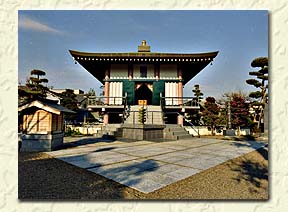 Main Hall and Its Principal Image of Buddha The main hall, which is built of reinforced concrete, is a very unique Ukimido-like building that looks as if floating on the surface of the water (Ukimido is built by Lake Biwa and looks as if floating on the surface of the lake). It was so constructed by the head priest's original idea. Its roof is a hip roof of single-layer copper sheet construction. The hall is a raised-style building with a veranda running on three sides, and visitors go up the stone steps on the front of the hall. The veranda and steps are provided with iron guardrails. The southern central room has a set of two wooden front doors that open out on hinges. Each of the doors bears the Temple's "Crest of the Moon and a Star," which is connected with that of the Chiba family as stated earlier. 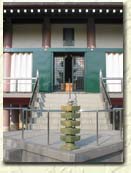 The rooms on both sides of the front doors have lattice walls with log bars set vertically as if the azekura style with a framework of horizontal bars were turned by 90 degrees. The five log bars are painted in the order of blue, yellow, red, white, and black starting with the most inside one. The log bars in the other room on the west side are also painted in the order of blue, yellow, red, white, and black starting with the most inside one. The eastern central room also has a set of two doors each with the Temple's "Crest of the Moon and a Star." The log bars in the room on the north side of the eastern central room are painted in the order of blue, yellow, red, white, and black starting with the most inside one. The log bars of the room on the south side of the eastern central room are painted in he order of blue, yellow, red, white, and black starting with the most inside one. Unlike the south and east sides, the northern central room has no doors. The five log bars in each of the three rooms on the north side are also painted in five different colors: in the order of black, white, red, yellow, and blue beginning with the most outside one in the room on the east side, in the order of blue, yellow, red, white, and black in the central room, and in the order of blue, yellow, red, white, and black beginning with the most inside one in the room on the west side. 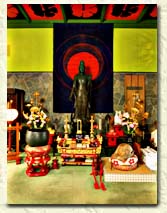 The western central room has a set of two doors with the "Crest of the Moon and a Star." The five log bars in the rooms on both sides of the western central room are painted in the order of black, white, red, yellow, and blue just as those in their corresponding rooms on the east side. The most outside log bars on both east and west sides are painted black, the most inside ones blue, and the central ones red. The surrounding pond is filled with clear water with the splendor of green water grasses and duck weeds. The pond also functions as a fire pond. In Buddhism, all things in the world are considered to be made from five elements: air, wind, fire, water, and earth. The log bars are painted in the five colors representing these five elements. That is, black represents earth, white water, red fire, yellow wind, and blue air. The roof is made of single-layer copper sheets. The rafters are all single-piece type ones arranged at considerable intervals (known as hitonoki mabara taruki), and the end of each rafter is painted white. A wind-bell is hung at each of the four corners of the roof. In the center of the roof are five figures of dogs instead of a wish-fulfilling gem (cintamani in Sanskrit) that is usually found on the roofs of Buddhist temples in Japan. The reason is that when Kukai, the founder of the Shingon Sect of Buddhism, penetrated deep into Mt. Koya to build Kongobu-ji Temple there in the reign of Emperor Saga (809-823), he met an old man with five dogs on the way and successfully guided by them to the destination. The old man is considered to have been an incarnation of a god. Thus he could accomplish his wish. In memory of these legendary dogs connected with the foundation of the sect, the Temple made the five figures of dogs instead of a wish-fulfilling gem. The five dogs are also related to the five elements of air, wind, fire, water, and earth. 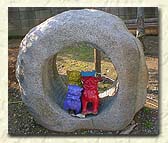 In the Main Hall, there are stone tablets (known as itabi) erected at 13 spots of the walls. These tablets are the Temple's treasures and are consequently kept with utmost care. The ceiling is a coffered ceiling (known as go-tenjo) with designs of an ornate Sanskrit letter transcribed as "a" in alphabet. A lantern is hung at each of the four corners of the ceiling. 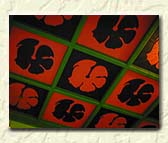 The Principal
Image of the Main Hall is the Holy Kannon (Arya-avalokitesvara in Sanskrit),
who is also called Yugao Kannon (Moonflower Kannon). The Image is about
175 centimeters or 5.74 feet high. Its ground base is an octagon with
each side being 37 centimeters or about 1.2 feet long, and the numerous
recurved petals on the pedestal of the Image are all good-shaped and beautiful.
Each side of the pedestal is 45 centimeters or about 1.48 feet long, and
it is decorated with beautiful lotus flower petals. The Principal Image
has the seal of great compassion on his face. His serene countenance,
gentle features, round cheeks, crown, protuberance on the head, bracelet,
heavenly garment looking as if flowing from the shoulder, length of silk
cloth draped round the body (called johaku), garment for the lower half
of the body and its hem, and string of precious stones and metal pieces
- all these are really beautiful. The finger signs are semui-in (a raised
hand with the palm open to signify giving the power of fearlessness) and
yogan-in (a lowered hand with the palm open to signify fulfilling people's
wishes). The Image is a well-proportioned gilt bronze statue. The Principal
Image of the Main Hall is the Holy Kannon (Arya-avalokitesvara in Sanskrit),
who is also called Yugao Kannon (Moonflower Kannon). The Image is about
175 centimeters or 5.74 feet high. Its ground base is an octagon with
each side being 37 centimeters or about 1.2 feet long, and the numerous
recurved petals on the pedestal of the Image are all good-shaped and beautiful.
Each side of the pedestal is 45 centimeters or about 1.48 feet long, and
it is decorated with beautiful lotus flower petals. The Principal Image
has the seal of great compassion on his face. His serene countenance,
gentle features, round cheeks, crown, protuberance on the head, bracelet,
heavenly garment looking as if flowing from the shoulder, length of silk
cloth draped round the body (called johaku), garment for the lower half
of the body and its hem, and string of precious stones and metal pieces
- all these are really beautiful. The finger signs are semui-in (a raised
hand with the palm open to signify giving the power of fearlessness) and
yogan-in (a lowered hand with the palm open to signify fulfilling people's
wishes). The Image is a well-proportioned gilt bronze statue. |